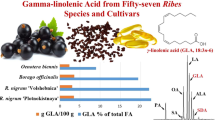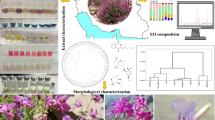Abstract
Oil concentration and fatty acid composition were determined in achenes of two annual Helianthus species (112 populations) and 11 perennial species (103 populations) from the Great Lakes region and the Central Great Plains of the U.S. The highest average oil concentration was observed in annualH. petiolaris Nutt. with 28.8%, followedbyH. annuus L. with 25.4%. Among the perennial species,H. hirsutus Raf. had the highest average oil concentration with 29.8%. The highest average palmitic (C16: 0) andstearic (C18:0) fatty acids were observed inH. tuberosus L. (6.5 and 3.5%, respectively), while the lowest values were observed inH. pauciflorus Nutt. ssp.subrhomboideus (4.2 and 2.1, respectively). The highest oleic acid (CI8:1) was observed inH. annuus (24.7%) and the highest linoleic (C18:2) was observed inH. pumilus Nutt. with 71.3%. Sufficient variability appears to be present in the wild species for enhancement of oil and fatty acid characteristics for cultivated sunflower.
Résumé
La concentratión de aceite y la composición del ácido graso fueron determinados en aquenios de dos especies deHelianthus anuales (112 poblaciones) y 11 especies perennes (103 poblaciones) procedentes de la región de los Grandes Lagos y de las Grandes Planicies Centrales de los EE. UU. El promedio mayor de concentración de aceite se observó en la anual H. petiolaris Nutt. con 28, 8%, seguida porH. annuus L. con 25, 4%. Entre las especies perennes, laH. hirsutus Raf. tuvo el promedio mayor de concentratión de aceite con 29, 8%. El promedio mayor de concentratión de ácidos grasos, palmítico (C16?0) y esteárico (C 18?0) fueron observados en laH. tuberosus L. (6, 5% y 3, 5%, respectivamente), mientras los valores más bajos fueron observados en laH. pauciflorus Nutt. ssp. subrhomboideus (4, 2 y 2, 1, respectivamente). El mayor ácido oléico (C18?l) se observó en laH. annuus (24, 7%) y el mayor ácido linoléico (C18?2) se observó en laH. pumilus Nutt. con 71, 3%. Parece haber suficiente variabilidad en las especies silvestres, para lograr un mejoramiento de las características de aceite y ácido graso del girasol cultivado.
Similar content being viewed by others
Literature Cited
DeHaro, A., and J. Fernandez-Martinez. 1991. Evaluation of wild sunflower(Helianthus) species for high content and stability of linoleic acid in the seed oil. Journal of Agricultural Science 116:359–367.
Dorrell, D. G., and E. D. P. Whelan. 1978. Chemical and morphological characteristics of seeds of some sunflower species. Crop Science 18:969–971.
Fuller, M., J. Diamond, and T. H. Aplewhite. 1967. High oleic sunflower oil. Stability and chemical modification. Journal of the American Oil Chemists’ Society 44:264–267.
Grandlund, M., and D. C. Zimmerman. 1975. Effects of drying conditions on oil content of sunflower(Helianthus annuus L.) seeds as determined by wide-line nuclear magnetic resonance (NMR). Proceedings of the North Dakota Academy of Sciences 27: 128–132.
Knowles, P. F., S. R. Temple, and F. Stolp. 1970. Variability in the fatty acid composition of sunflower seed oil. Pages 215–218in Proceedings of the 4th International Sunflower Conference, Memphis, TN. International Sunflower Association, Toowoomba, Australia.
Metcalfe, L. D., and C. N. Wang. 1981. Rapid preparation of fatty acid methyl esters using organic base catalyzed transesterification. Journal of Chromato-graphic Science 19:530–535.
Robertson, J. A., J. K. Thomas, and D. Burdick. 1971. Chemical composition of the seed of sunflower hybrids and open pollinated varieties. Journal of Food Science 36:873–876.
Robertson, J. A., W. H. Morrison, and R. L. Wilson. 1979. Effects of planting location and temperature on oil content and fatty acid composition of sunflower seeds. USDA, Agricultural Research Services Results. Southern Series No. 3, Washington, D.C.
Schilling, E. E., and C. B. Heiser. 1981. Infrageneric classification ofHelianthus (COMPOSITATE). Taxon 30:393–103.
Seiler, G. J. 1982. Variation in oil and oil quality of wild annual sunflower (Helianthus annuus L.) populations in a uniform environment. Pages 215–218in Proceedings of the 10th International Sunflower Conference, Surfer’s Paradise, Australia. International Sunflower Association, Toowoomba, Australia.
—. 1983. Effect of genotype, flowering date, and environment on oil content and oil quality of wild sunflower seed. Crop Science 23:1063–1068.
—. 1985a. Evaluation of seeds of sunflower species for several chemical and morphological characteristics. Crop Science 25:183–187.
—. 1985b. Interrelation of fatty acids in oil of wild annual sunflower (Helianthus annuus L.). Pages 529–534in Proceedings of the 11th International Sunflower Conference, Mar del Plata, Argentina. International Sunflower Association, Toowoomba, Australia.
—. 1986. Analysis of the relationships of environmental factors with seed oil and fatty acid concentrations of wild annual sunflower. Field Crops Research 15:57–72.
—. 1992. Utilization of wild sunflower species for the improvement of cultivated sunflower. Field Crops Research 30:195–230.
—,M. E. Carr, and M. O. Bagby. 1990. Renewable resources from wild sunflowers (Helianthus spp., ASTERACEAE). Economic Botany 45:4–15.
Soldatov, K. I. 1976. Chemical mutagenesis in sunflower breeding. Pages 352–357in Proceedings of the 7th International Sunflower Conference, Krasnodar, USSR. International Sunflower Association, Toowoomba, Australia.
Thompson, T. E., D. C. Zimmerman, and C. E. Rogers. 1981. WildHelianthus as genetic resource. Field Crops Research 4:333–343.
Author information
Authors and Affiliations
Rights and permissions
About this article
Cite this article
Seiler, G.J. Oil concentration and fatty acid composition of achenes of North AmericanHelianthus (Asteraceae) species. Econ Bot 48, 271–279 (1994). https://doi.org/10.1007/BF02862328
Received:
Accepted:
Issue Date:
DOI: https://doi.org/10.1007/BF02862328




